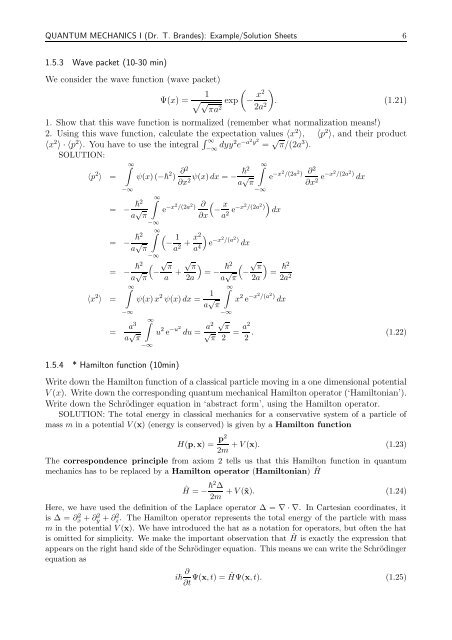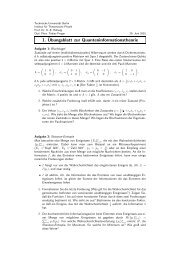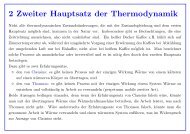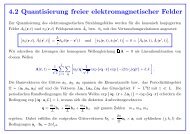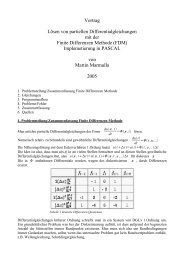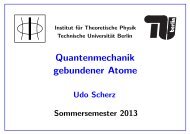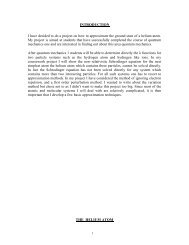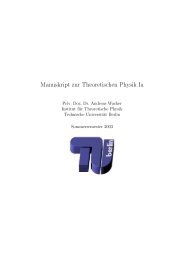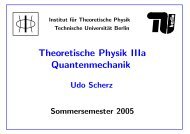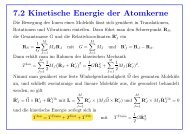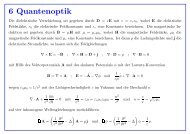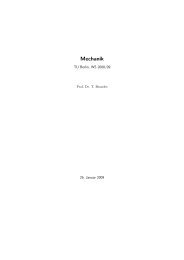1.1 The Radiation Laws and the Birth of Quantum Mechanics
1.1 The Radiation Laws and the Birth of Quantum Mechanics
1.1 The Radiation Laws and the Birth of Quantum Mechanics
You also want an ePaper? Increase the reach of your titles
YUMPU automatically turns print PDFs into web optimized ePapers that Google loves.
QUANTUM MECHANICS I (Dr. T. Br<strong>and</strong>es): Example/Solution Sheets 6<br />
1.5.3 Wave packet (10-30 min)<br />
We consider <strong>the</strong> wave function (wave packet)<br />
Ψ(x) =<br />
1<br />
√√ exp<br />
πa<br />
2<br />
(− x2<br />
2a 2 )<br />
. (1.21)<br />
1. Show that this wave function is normalized (remember what normalization means!)<br />
2. Using this wave function, calculate <strong>the</strong> expectation values 〈x 2 〉, 〈p 2 〉, <strong>and</strong> <strong>the</strong>ir product<br />
〈x 2 〉 · 〈p 2 〉. You have to use <strong>the</strong> integral ∫ ∞<br />
−∞ dyy2 e −a2 y 2 = √ π/(2a 3 ).<br />
SOLUTION:<br />
〈p 2 〉 =<br />
〈x 2 〉 =<br />
∫ ∞<br />
−∞<br />
= − 2<br />
a √ π<br />
= − 2<br />
a √ π<br />
ψ(x) (− 2 ) ∂2<br />
2<br />
ψ(x) dx = −<br />
∂x2 a √ π<br />
∫ ∞<br />
−∞<br />
∫ ∞<br />
−∞<br />
= − 2 ( √ π<br />
a √ −<br />
π a<br />
∫ ∞<br />
−∞<br />
= a3<br />
a √ π<br />
e −x2 /(2a 2 )<br />
∫ ∞<br />
−∞<br />
∂<br />
(<br />
− x ) /(2a 2 )<br />
∂x a 2 e−x2 dx<br />
(− 1 a 2 + x2<br />
a 4 )<br />
e −x2 /(a 2) dx<br />
√ π<br />
) + = − 2<br />
2a a √ π<br />
ψ(x) x 2 ψ(x) dx = 1<br />
a √ π<br />
∫ ∞<br />
−∞<br />
1.5.4 * Hamilton function (10min)<br />
∫ ∞<br />
−∞<br />
(<br />
−<br />
e −x2 /(2a 2 ) ∂ 2<br />
√ π<br />
)<br />
= 2<br />
2a 2a 2<br />
x 2 e −x2 /(a 2) dx<br />
∂x 2 e−x2 /(2a 2) dx<br />
u 2 e −u2 du = a2<br />
√ π<br />
√ π<br />
2 = a2<br />
2 . (1.22)<br />
Write down <strong>the</strong> Hamilton function <strong>of</strong> a classical particle moving in a one dimensional potential<br />
V (x). Write down <strong>the</strong> corresponding quantum mechanical Hamilton operator (‘Hamiltonian’).<br />
Write down <strong>the</strong> Schrödinger equation in ‘abstract form’, using <strong>the</strong> Hamilton operator.<br />
SOLUTION: <strong>The</strong> total energy in classical mechanics for a conservative system <strong>of</strong> a particle <strong>of</strong><br />
mass m in a potential V (x) (energy is conserved) is given by a Hamilton function<br />
H(p, x) = p2<br />
+ V (x). (1.23)<br />
2m<br />
<strong>The</strong> correspondence principle from axiom 2 tells us that this Hamilton function in quantum<br />
mechanics has to be replaced by a Hamilton operator (Hamiltonian) Ĥ<br />
Ĥ = − 2 ∆<br />
+ V (ˆx). (1.24)<br />
2m<br />
Here, we have used <strong>the</strong> definition <strong>of</strong> <strong>the</strong> Laplace operator ∆ = ∇ · ∇. In Cartesian coordinates, it<br />
is ∆ = ∂x 2 + ∂2 y + ∂2 z . <strong>The</strong> Hamilton operator represents <strong>the</strong> total energy <strong>of</strong> <strong>the</strong> particle with mass<br />
m in <strong>the</strong> potential V (x). We have introduced <strong>the</strong> hat as a notation for operators, but <strong>of</strong>ten <strong>the</strong> hat<br />
is omitted for simplicity. We make <strong>the</strong> important observation that Ĥ is exactly <strong>the</strong> expression that<br />
appears on <strong>the</strong> right h<strong>and</strong> side <strong>of</strong> <strong>the</strong> Schrödinger equation. This means we can write <strong>the</strong> Schrödinger<br />
equation as<br />
i ∂ Ψ(x, t) = ĤΨ(x, t). (1.25)<br />
∂t


